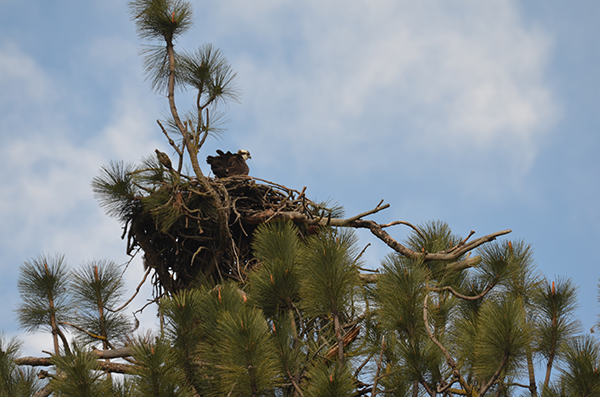One of the sure signs of spring is the return of our seasonal birds. Many people think of the robins out in the yard pulling worms after a rain or flocks of red-winged black birds calling as they establish territory in the cattail and tule marshes. But when I think of bird behavior in the spring, I think of fish heads in my front yard, arm-sized branches falling at random from the sky, and the aerial courtship of osprey.
Sitting in my front yard is a large ponderosa pine with a broken top that rises above the nearby willow, cottonwoods, and agricultural fields, making it an excellent nesting spot for my seasonal neighbors: a pair of osprey. I get a front-row vantage point to watch these fish-hunting hawks progress through the season.
Osprey are the ultimate snowbird, spending the warm months near lakes and rivers up north, and in the winter, finding warmer waters in Mexico and even as far as South America. Each spring, osprey make the long flight back north to their previous year’s nesting site, and in my case to a ponderosa near the banks of Hangman Creek.
Upon their return, they have some housekeeping and courtship activities to attend to around their nest sites. Males will get busy finding sticks to refresh their nesting sites. As the male gathers stick of the correct size, it will slam them into other tree branches, causing the cascade of branches to fall seemingly at random in my yard. The female takes on the task of arranging those branches. Nests will start about three feet in diameter, but over several years can reach ten feet wide.

Ospreys have a couple unique behaviors in the hawk world. Their long, slow wing beats allows less maneuverability and prevents them from hunting and flying in forest. This, and safety from predators, is why osprey prefer to nest in open areas. As a way to discourage them from nesting on utility poles, many companies install taller nesting platforms.
Like some neighbors, they can get a little loud at times. During this nest-building period, a magnificent courtship display occurs, often referred to as the “sky dance” or “fish flight.” With legs dangling, males will fly and hover—
sometimes up to 600 feet above the nest—with fish or nesting material clasped in their talons. They will utter a screaming call as they swoop and hover, losing altitude until they reach the nest.
Unlike other birds of prey that feed on fish, the osprey’s diet consists almost entirely of fish. Watching osprey hunt is an exciting experience in aerial maneuverability. Unlike other fish-hunting raptors, osprey will dive head and talons first into the water, completely submerging. Osprey also have specialized pads on their toes that allow them to hold on to slippery fish.
During the nesting period, males do the majority of the fishing and will feed both the female and the hatchlings. Once they have a fish, they will hold it straight under their bodies like a torpedo. Males will frequently sit on branches below the nest to devour their meals and make them ready to share, discarding the less appetizing head and backbone, leaving them for me to find strewn about the yard.
They do have to deal with pesky neighbors of their own. Both males and females will fiercely defend their nest site. When they first arrive to my ponderosa, they usually have to kick out a pair of geese that like to hang out in the nest, which is odd because geese nest on the ground. During the rest of the season, I frequently hear the defensive call of osprey chasing after magpies and sometimes red-tail hawks. This behavior makes them good neighbors as the osprey’s ability to chase off other hawks keeps our free-roaming chickens a little safer.
In late April or May, the females will lay one to four eggs, which will hatch in three weeks. My osprey neighbors will then spend the next six weeks raising their young till they are ready to fly. The young will spend the next two months with their parents learning to fish, before the whole family makes their way south again.
The numerous lakes and rivers in the Spokane area make this region excellent seasonal habitat for osprey and give us ample opportunity to watch their unique behaviors. I for one am glad that they are my neighbors, even if they occasionally leave fish heads in the yard.
Feature photo: Male osprey gathering nest material. // Photo: Adam Gebauer













